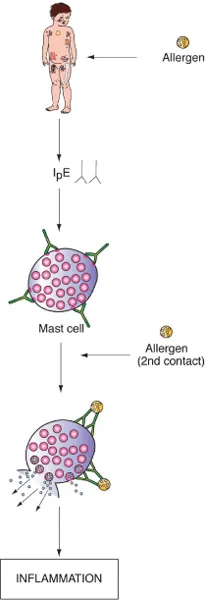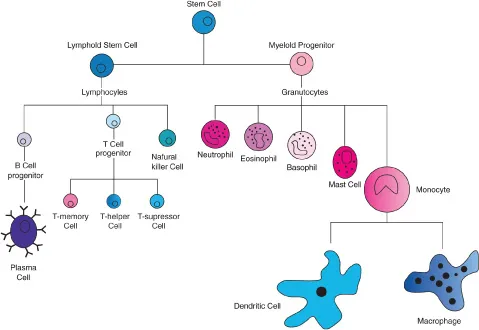![]()
1
On Allergy and
Allergic Reactions
This chapter is a general introduction and covers three aspects of childhood allergies, including a short overview on the immune system. For further reading on the immune system, the reader could refer to more specialized literature or to the Internet (see chapter on references).
• What is allergy?
• What causes allergy?
• What are the main manifestations of allergy?
In short, allergy is a feature, not a disease. It is due to the ability of the human body to produce IgE against harmless substances, called allergens. Allergy is a very dynamic process, especially in young children. Allergic reactions come and go: children can grow out of allergies, and new allergies can occur at any age, but the occurrence of new allergies in elderly people is very exceptional.
What is allergy?
The term allergy is used to describe an inappropriate and harmful response of the immune system to a harmless foreign substance (usually a protein), that results in an immune response that can cause symptoms and disease in a predisposed person. Allergy in itself is not a disease, nor is it a diagnosis. It is merely a genetic feature of the human body: people can be allergic or non-allergic. Nowadays, most people are non-allergic, but over last the three decades more and more people, especially children have become allergic.
Allergy means that the body reacts in a particular way to the environment by producing a specific type of antibody. That specific antibody, called immunoglobulin E (IgE), induces a hypersensitivity reaction of the body through activating different cell types, including mast cells (see Fig. 1). Cell activation can lead to “inflammation,” which means that the body attains a state of alertness, and that in the different organs (such as the skin or the airways) swelling, redness and cell infiltration occurs. It is the inflammation that causes the symptoms. If the inflammation occurs in the skin, eczema will result. In the airways, inflammation can result in asthma (lower airways) or rhinitis (upper airways). Symptoms can also occur in other organs such as the intestine, eyes, or even the brain.
Fig. 1 Mechanism of an allergic reaction.
- A potentially allergic child comes into contact with an allergen (through inhalation, ingestion, or through direct contact with the skin).
- Production of immunoglobulin E (IgE) by certain types of cells (B lymphocytes). The IgE circulates in the blood, and comes into contact with different cells, tissues and organs.
- IgE binds to mast cells via an IgE-receptor in the membrane of the mast cell.
- A second contact with the same allergen results in destruction of the cell wall of the mast cell.
- Different molecules are released by the mast cell. One of these many molecules is histamine.
- Various molecules (mediators, cytokines, and others) from the mast cell induce attraction and activation of other cells, resulting in inflammation. This inflammation occurs most commonly in the nose (rhinitis), in the lungs (asthma) and in the skin (eczema).
On the Immune System
Through a process known as the immune response, the immune system protects us against invaders from the environment. It is composed of many types of cells that collectively protect the body from bacterial, parasitic, fungal, and viral infections. The immune system reacts to every foreign substance that we encounter in the environment, even to substances that are beneficial or totally harmless, such as food. Besides a protective function against invaders, the immune system has other functions that keep us healthy. One example is that the immune system protects us from growth of tumor cells.
White blood cells, also called leukocytes, make up the main cell type of the immune system. These cells are produced in lymphoid organs like the bone marrow, thymus and spleen and move within the body through channels that are known as lymphatic vessels.
Two major groups of white blood cells play a role in immune response: myelocytes and lymphocytes. Myelocytes, being phagocytic, engulf and chew up invading substances, while lymphocytes play several different roles in combating invaders. Lymphocytes are classified into B and T cells. B cells produce and secrete antibodies, while T cells help to destroy the invaders by regulating the function of other cells.
The lymphocytic network is a very complex network, comprising many types of lymphocytes. Schematically, it is mainly composed of two parts: one part (B cells) being responsible for the production of different types of antibodies, each with a specific role in our defence against microorganisms (viruses, bacteria, etc); and the second part comprises different types of cells that are directly involved in protecting and defending us. This latter part is mainly built up of different T subsets of lymphocytes. These lymphocytes secrete substances that help to regulate the functions of other cells in the defence of the body. These substances are known as cytokines, lymphokines, and interleukins.
The immune system is built up and refined over millions of years. Its various different functions are carried out by different types of cells, giving rise to a lot of overlapping functions, and resulting in a very robust and reliable defence system.
Fig. 2 Organs of the immune system.
The Organs of the Immune System (Fig. 2)
Bone Marrow—All the cells of the immune system are initially derived from the bone marrow, more specifically from bone marrow-derived stem cells. These cells differentiate into either mature cells of the immune system or into precursors of cells that migrate out of the bone marrow to continue their maturation elsewhere. Cells that are produced by the bone marrow are: B lymphocytes (which are responsible for antibody production), natural killer lymphocytes, granulocytes and immature thymocytes (that will mature in the thymus), in addition to red blood cells and platelets.
Thymus—The function of the thymus is to produce mature T lymphocytes. Through a remarkable maturation process sometimes referred to as “thymic education” T cells that are beneficial to the immune system are spared, while those T cells that might evoke a non-favorable autoimmune response are eliminated. The mature T cells are then released into the bloodstream.
Spleen—The spleen is an immunologic filter of the blood. It is made up of different types of cells, including B cells, T cells, macrophages, dendritic cells, natural killer cells and red blood cells. The main function of the spleen is to capture foreign materials (antigens) from the blood. An immune response in the spleen is initiated when the macrophage or dendritic cells present the antigen to the appropriate B or T cells. The spleen can be considered as an immunological conference center. In the spleen, B cells become activated and produce large amounts of antibodies. Also, old red blood cells are destroyed in the spleen.
Lymph Nodes— The lymph nodes function as immunologic filters and are found throughout the body. Composed mostly of T cells, B cells, dendritic cells and macrophages, the nodes drain fluid from most of our tissues. Antigens are filtered out of the lymph in the lymph nodes before the lymph returns to the circulation. In a similar fashion as the spleen, the macrophages and dendritic cells that capture antigens present these foreign materials to T and B cells, consequently initiating an immune response.
The Cells of the Immune System (Fig. 3)
1. T-Cells— T lymphocytes are usually divided into two major subsets: helper T cells (Fig. 4) and killer/suppressor T cells. The two types of cells are functionally different.
The T helper subset (Th cells), also called the CD4+ T cell, is a pertinent coordinator of immune regulation. Nowadays four types of CD4+ cells are distinguished: Th-1, Th-2, Th-17 and T-reg (regulatory T cells), and it is very likely that in the future further discoveries will lead to the identification of other types of T cells (Fig. 4). The main function of the T helper cell is to augment or potentiate and regulate immune responses through the secretion of specialized factors that activate other white blood cells to fight off infection. Th-1 cells are involved in normal immune responses against viruses or bacteria, while Th-2 cells are mainly involved in allergic reactions, inducing IgE production via a number of mechanisms. Th-17 have recently been discovered and seem to be involved in a number of specific immune responses, including responses that can lead to the occurrence of eczema. T-reg cells are mainly regulating cells that are responsible for a healthy balance of immune responses throughout the body.
Fig. 3 Different cells of the immune system.
Fig. 4 The 4 major types of T helper cells (CD4+ T cell).
The second type of T cells is called the T killer/suppressor subset, also called as CD8+ T cells. These cells are important in directly killing certain tumor cells, viral-infected cells and sometimes parasites. The CD8+ T cells are also important in downregulation of immune responses.
Both types of T cells can be found throughout the body. They often depend on the secondary lymphoid organs (the lymph nodes and spleen) as sites where activation occurs, but they are also found in other tissues of the body, most conspicuously the liver, lung, blood, and intestinal and reproductive tracts.
2. Natural Killer Cells—Natural killer cells, often referred to as NK cells, are similar to the killer T cell subset (CD8+ T cells). They function as cells that directly kill certain tumor cells and viral-infected cells, most notably herpes and cytomegalovirus-infected cells. NK cells, unlike the CD8+ (killer) T cells, kill their targets without a prior “conference” in the lymphoid organs. However, NK cells that have been activated due to secretions from CD4+ T cells will kill their tumor or viral-infected targets more effectively.
3. B Cells—The major function of B lymphocytes is the production of different types of antibodies in response to foreign proteins of bacteria, viruses, and t...




